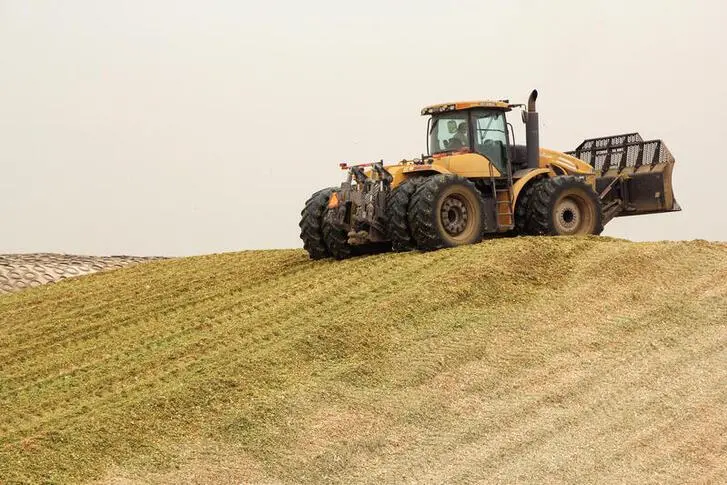PHOTO
FORT COLLINS, Colo.- As if the grain markets needed any additional excitement to start off the year, the U.S. Department of Agriculture will be piling on with its largest annual data dump on Tuesday, and the expectations are mostly price-supportive.
That goes along with the latest storyline of shrinking U.S. and global supplies, which has sent Chicago-traded corn, soybean and wheat futures to the highest levels in more than six years.
But although stocks are seen smaller on Tuesday, analysts have abandoned their recent “group think” tendency when it comes to U.S. corn and soybean production. Those wide harvest scenarios could potentially set up a large and unexpected impact on domestic inventory.
USDA is set to publish the reports on Tuesday at noon EST (1700 GMT).
U.S. PRODUCTION
The average trade estimates for 2020 U.S. corn and soybean production would suggest the market does not expect major adjustments versus previous figures, a potentially faulty assumption.
On average, analysts peg U.S. corn yield at 175.3 bushels per acre, down from 175.8 bpa in November, and soybean yield at 50.5 bpa, down from 50.7. The average corn production estimate is down just 37 million bushels from November and the soybean crop is seen down 12 million.
But the range of guesses is historically wide. Corn and soybean yield guesses have a 4.4 bpa and 2.3 bpa range, respectively, the largest ahead of the January report in at least 17 years. Seven of the 25 analysts polled by Reuters see corn yield unchanged from or higher than in November, and nine of the 25 see the same thing for soybeans.
Harvested corn area has a 2.16 million-acre range of guesses, not the largest in history but certainly on the high side, and that is driving the huge 678 million-bushel range in production estimates.
Soybean acres have a historically smaller range of trade guesses, but the wide yield scenarios put the production range at 176 million bushels, just 1 million larger than the entire 2020-21 U.S. carryout as predicted by USDA last month.
The adage that small crops tend to get smaller breaks down in the case of soybeans and final production. The troubled 2019 crop ended barely higher than the November estimate, but the five crops before that, all strong harvests, were smaller than the November prediction. Between 2007 and 2013, all soybean crops except for 2010 ended up larger than in November.
In the last decade, only three corn crops ended up larger than what had been predicted in November: 2011, 2012 and 2017. The most recent featured record yields, but the other two were poor harvests. However, these increases were very small, and the years where the crops got smaller featured much larger adjustments.
U.S. STOCKS AND DEMAND
Despite the expectation for smaller U.S. crops, analysts seem to believe that USDA might increase domestic corn and soybean demand. U.S. ending stocks for both corn and soybeans are seen falling about three times as much as the expected production decline.
The average trade guess for U.S. corn ending stocks is 1.599 billion bushels, down from 1.702 billion in December, and soybeans are seen at 139 million bushels, down from 175 million. Only a couple analysts see the scenario for corn stocks to increase from December, but none of them see a possibility for soybeans to increase or even stay the same.
The quarterly stocks report has been somewhat wild for traders over the past year, as USDA’s revisions of the past quarter’s stocks have been unusually large. Although Dec. 1, 2020, stocks are the focus of Tuesday’s report, USDA’s standard procedure suggests there could be changes to Sept. 1 stocks, though the situation is slightly different this year.
USDA shocked the market in September when it took an unprecedented 205 million bushels out of the June 1 corn stocks. Also, the agency in January 2020 increased Sept. 1, 2019, stocks by a historically large 106 million bushels.
But those two adjustments are likely analogous, because USDA this past year moved the corn production review period up to September from December to match that of soybeans. This could imply that an extreme Sept. 1 corn adjustment is less likely this time, but there are no guarantees.
The Sept. 1, 2019, stock revisions a year ago were abnormally large for both soybeans and wheat. Soybeans were cut by 4 million bushels and wheat declined 39 million bushels.
For Dec. 1, 2020, stocks, analysts see a three-year high for the date in corn, a four-year low for soybeans, and a six-year low for wheat.
OTHER NOTABLES
U.S. winter wheat planted acres for the 2021 harvest are seen at 31.528 million acres, more than 1 million above last year’s 111-year low. If realized, that would be the first yearly rise in U.S. winter wheat acres in eight years.
But the low end of the trade ranges suggests there is a possibility, albeit slight, for wheat acres to fall on the year. If wheat acres land below expectations, that supports larger springtime plantings of crops like corn, soybeans and sorghum.
In the last 21 years, acres in USDA’s winter wheat seedings report have come in above the trade average only four times, the most recent two being 2020 and 2018.
Analysts believe that unfavorable conditions in parts of South America will lead USDA to reduce the 2020-21 crop estimates there. Combined between Argentina and Brazil, the corn harvest is seen falling by close to 4 million tonnes from December and soybeans are seen down about 3 million.
World ending stocks for 2020-21 are seen substantially lower than December for both corn and soybeans. The average trade guesses place corn and soybean stocks at six- and five-year lows, respectively, but the lowest trade estimates suggest seven-year lows are possible for both. Wheat stocks are expected to remain record-large.
Traders will also be closely watching Chinese demand numbers, particularly for corn. USDA in December increased 2020-21 China corn imports to 16.5 million tonnes from 13 million a month earlier, but many market participants believe the number should be higher.
(Editing by Matthew Lewis) ((karen.braun@thomsonreuters.com; Reuters Messaging: karen.braun.thomsonreuters.net@reuters.com; Twitter: @kannbwx))












